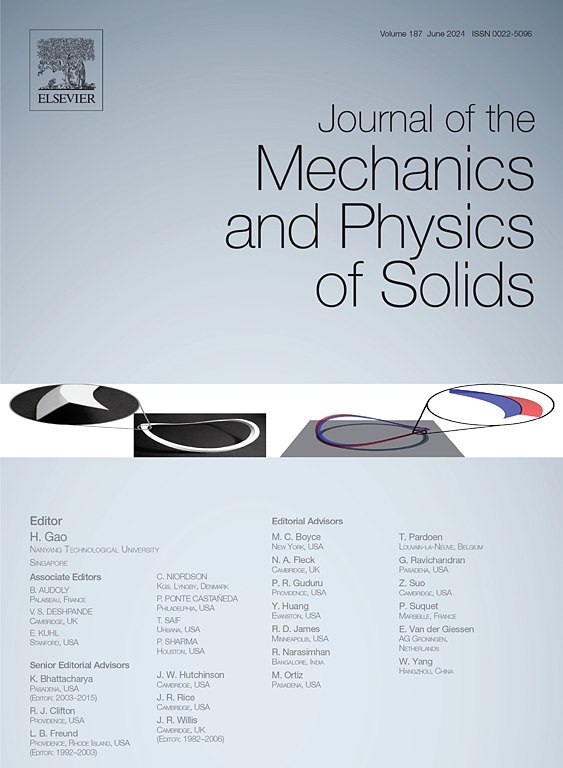基于双尺度渐近均质化的异质材料应变梯度相场模型
IF 5
2区 工程技术
Q2 MATERIALS SCIENCE, MULTIDISCIPLINARY
引用次数: 0
摘要
非均质材料由于其固有的微观组织非均质性,其宏观断裂行为与均质材料有显著差异,表现出断裂能和应变梯度等各向异性效应。为了研究微观结构对宏观断裂行为的影响,本文提出了一种新的多尺度相场模型。基于双尺度渐近展开理论,构建了一个等效的多场耦合边值框架,该框架包括应变梯度弹性子模型和均质相场子模型。通过严格的数学推导,在不依赖任何额外假设的情况下,获得了表征弹性本构关系和断裂性能的均匀张量。此外,为了区分荷载分量对裂纹扩展的贡献,引入了基于正交投影的应力和高阶应力能量分解策略。与全尺寸仿真相比,该模型在保持精度的同时显著降低了计算成本。数值模拟结果表明,该模型能较好地反映微观组织对裂纹扩展方向的影响。此外,该模型有效地展示了应变梯度对裂纹扩展的阻碍作用,为非均质材料断裂中的尺寸效应提供了新的认识。这为研究非均质材料的多尺度断裂行为提供了一个新的框架。本文章由计算机程序翻译,如有差异,请以英文原文为准。
A strain gradient phase field model for heterogeneous materials based on two-scale asymptotic homogenization
Due to the inherent microstructural heterogeneity of heterogeneous materials, their macroscopic fracture behavior differs significantly from that of homogeneous materials, exhibiting phenomena such as anisotropic fracture energy and strain gradient effects. To investigate the effect of microstructure on macroscopic fracture behavior, this study proposes a novel multiscale phase field model. Based on the theory of two-scale asymptotic expansion, the model constructs an equivalent multi-field coupled boundary value framework, which includes both a strain gradient elasticity submodel and a homogenized phase field submodel. Through rigorous mathematical derivation, homogenized tensors that characterize the elastic constitutive relations and fracture properties are obtained without relying on any additional assumptions. Moreover, to distinguish the contributions of load components to crack propagation, energy decomposition strategies based on orthogonal projection are introduced for stress and higher-order stress. Compared to full-scale simulations, the proposed model significantly reduces computational cost while maintaining accuracy. Numerical simulations show that the model accurately captures the influence on crack propagation direction induced by microstructure. Additionally, the model effectively demonstrates the hindering effect of strain gradients on crack propagation, offering new insights into the size effect in the fracture of heterogeneous materials. This work provides a new framework for studying the multiscale fracture behavior of heterogeneous materials.
求助全文
通过发布文献求助,成功后即可免费获取论文全文。
去求助
来源期刊
CiteScore
9.80
自引率
9.40%
发文量
276
审稿时长
52 days
期刊介绍:
The aim of Journal of The Mechanics and Physics of Solids is to publish research of the highest quality and of lasting significance on the mechanics of solids. The scope is broad, from fundamental concepts in mechanics to the analysis of novel phenomena and applications. Solids are interpreted broadly to include both hard and soft materials as well as natural and synthetic structures. The approach can be theoretical, experimental or computational.This research activity sits within engineering science and the allied areas of applied mathematics, materials science, bio-mechanics, applied physics, and geophysics.
The Journal was founded in 1952 by Rodney Hill, who was its Editor-in-Chief until 1968. The topics of interest to the Journal evolve with developments in the subject but its basic ethos remains the same: to publish research of the highest quality relating to the mechanics of solids. Thus, emphasis is placed on the development of fundamental concepts of mechanics and novel applications of these concepts based on theoretical, experimental or computational approaches, drawing upon the various branches of engineering science and the allied areas within applied mathematics, materials science, structural engineering, applied physics, and geophysics.
The main purpose of the Journal is to foster scientific understanding of the processes of deformation and mechanical failure of all solid materials, both technological and natural, and the connections between these processes and their underlying physical mechanisms. In this sense, the content of the Journal should reflect the current state of the discipline in analysis, experimental observation, and numerical simulation. In the interest of achieving this goal, authors are encouraged to consider the significance of their contributions for the field of mechanics and the implications of their results, in addition to describing the details of their work.

 求助内容:
求助内容: 应助结果提醒方式:
应助结果提醒方式:


